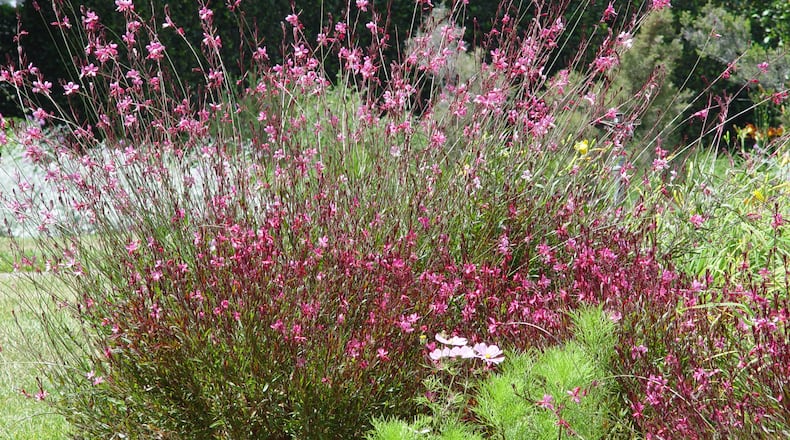Yet Gaura didn’t come into widespread cultivation until the 1990s when the first hybrid, Siskiyou Pink, was introduced to California garden centers. This added a vivid red tinge to the foliage and clear bright pink blossoms. Although very popular at first, it didn’t take off like it should due to return of adequate rain years when nobody worried about water. Then the inevitable drought struck, and suddenly everyone is discovering what a great perennial this is for dry gardens.
It’s the openness of the large plant that gives it such incredible value in the landscape. Consider Gaura similar to ornamental grasses in character and density, but with great floral color. Use it the same way as grasses to fill gaps or spice up neglected hot spots.
Its long blooming season means this may be the only flower blooming during the dog days. For that reason, spread them around the landscape to ensure you have lots of interest in this difficult time. They’ll bloom till frost in most locations.
Gaura is a perfect companion for cactus and succulents. Succulents are rigid and visually static for the most part, so little animation occurs where they grow. Spot in a few Gaura for its whirling butterflies and you have a livelier scenario. Due to the transparent nature of the upper flower stems, you get glimpses of succulents through them in the garden for wonderful surprises.
In dry areas where so many plants were lost to drought, Gaura is a replacement you can count on to look great all season. It’s a true chameleon for achieving that abundant English cottage garden look with little water. However, beware of too much water as it’s their Achilles heel, so group only with drought lovers. Slopes or well drained soils are a must.
At the end of the growing season or early winter, Texans cut back their Gaura the same way we cut back dormant ornamental grasses. This forces all new growth the following season for maximized vigor and bloom. Failure to do so makes the next year’s plant become floppy with too much new growth on top of the old.
When buying Gaura, remember the tap root. Start off with a quart-sized pot so you’ll get a healthy tap root. Older plants from nursery stock may have a distorted tap root from encountering the bottom of the pot. While larger plants do fine under increased irrigation, this shortens their life span. Where water is limited, those youngsters with the tap root will out-perform them in the long run, naturally. Starting with young plants is essential in very dry locations where extreme drought tolerance is required.
Like so many native wildflowers throughout the West, Gaura is the most reliable under variable conditions. It is a perfect match for fall planting with California natives and most Mediterranean garden favorites. Above all it is the beauty of light and movement that transforms spaces around them with whirling butterflies, that never seem to land no matter how still the day.
———
Maureen Gilmer is an author, horticulturist and landscape designer. Learn more at www.MoPlants.com
About the Author
